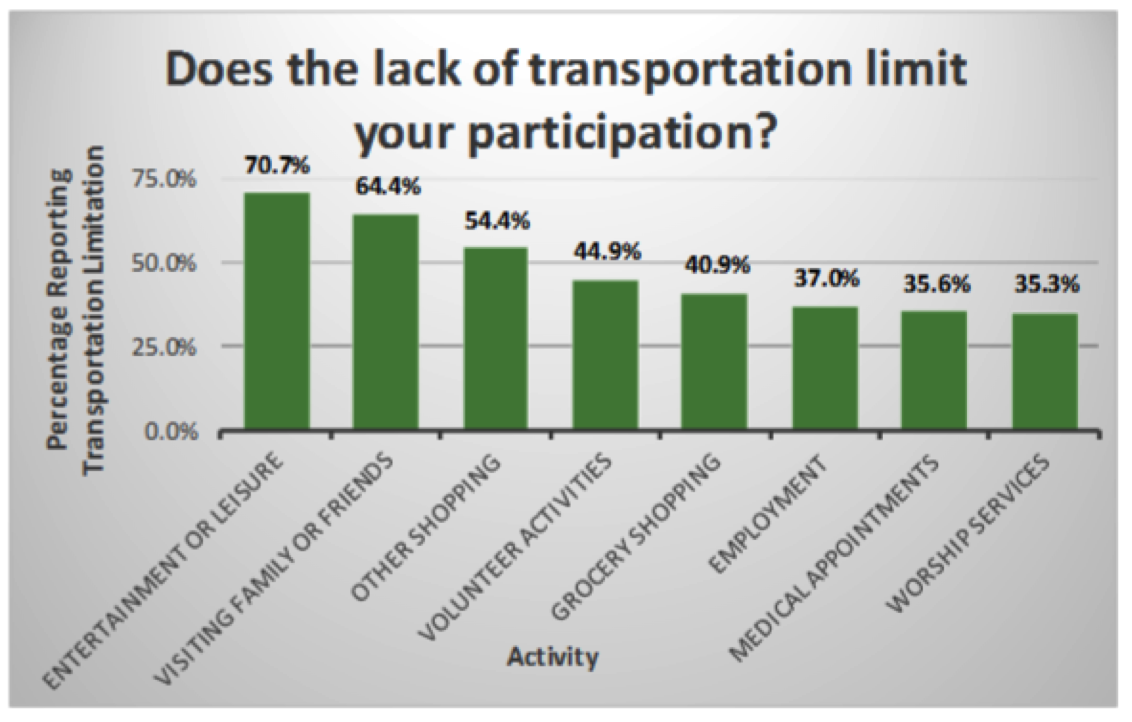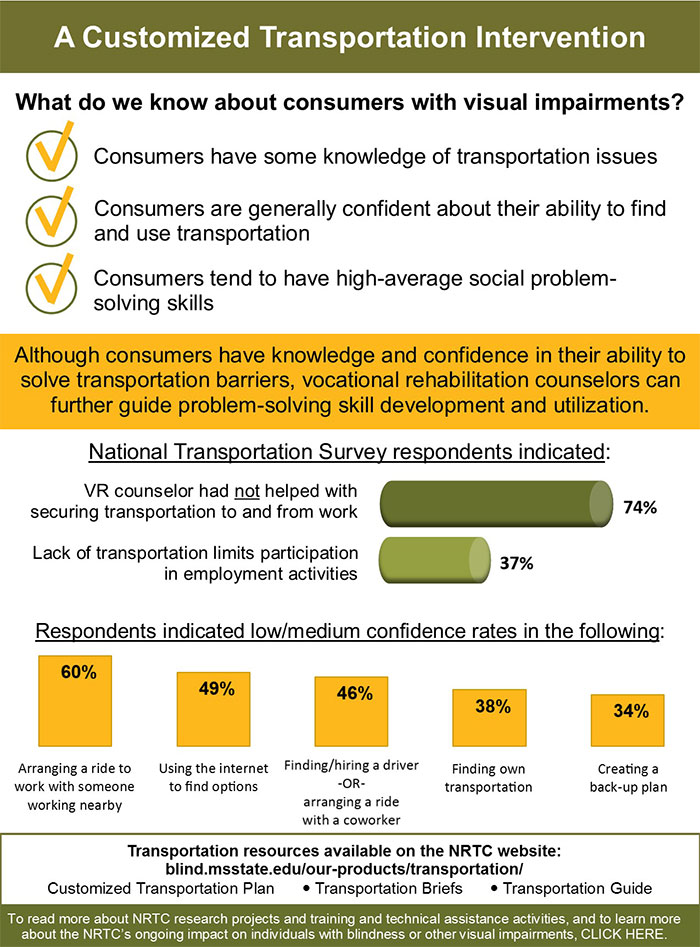Principal Investigator: Adele Crudden, crudden@ra.msstate.edu
Transportation can be a huge barrier to successful employment for individuals who are blind or visually impaired. Lack of viable transportation options limits them in their job searches and employment possibilities.
In order to gain insight into this problem, the National Research and Training Center on Blindness and Low Vision (NRTC) conducted a study in Alabama with individuals who were blind and visually impaired and on the job market. This study employed a Customized Transportation Intervention program with the aim of helping these individuals overcome their transportation barriers.
Participants for this study were referred by their VR counselors and had to be actively seeking employment in order to qualify. A total of 53 referrals were assigned, based on where they lived, to an intervention group or a comparison group.
Those in the intervention group were assigned to work with a transportation coordinator. Coordinators were trained by NRTC staff to work one-on-one with their clients to craft individualized transportation solutions that would effectively address each client’s unique circumstances. Those in the comparison group received a $25 gift card for completing the pre-tests, and received a document discussing transportation options.
Before beginning the program, participants completed an orientation and mobility screening and pre-tests in three areas:
- Self-efficacy: testing respondents’ belief in their own ability to successfully complete transportation-related tasks
- Problem solving: judging how participants view problems and their strategies for overcoming obstacles
- Transportation knowledge: gauging how much participants knew about securing transportation and transportation etiquette
The pre-tests provided a basis for understanding how well participants might be expected to deal with their transportation challenges. Forty-eight of the referrals completed pre-testing: 16 in the intervention group and 32 in the comparison group.
Self-efficacy results:
- Mean scores were at or above average, indicating participants had a good amount of confidence in their own abilities.
Problem solving results:
- Mean scores were at or above average, indicating problem solving abilities that are at least average when compared to those of the normal population.
- There were no differences in problem solving skills by age, gender, or race.
- The results indicate that participants face problems with less emotional stress and are efficient and effective problem solvers.
Transportation knowledge results:
- Scores indicate that participants were generally knowledgeable about transportation.
- Respondents had less knowledge on subjects like tipping drivers, maximizing independence, and paying per-mile rates.
Post-tests in the same three areas listed above were sent out roughly a year after the pre-tests were completed. Thirty-two were completed, six from the intervention group. After working with their transportation coordinator for approximately 60 days, participants in the intervention group also completed a satisfaction survey. They were asked to talk about their satisfaction with the program and whether they would recommend it for others.
Satisfaction results:
- Eleven of twelve respondents from the intervention group indicated they were happy about the services provided by their transportation coordinator.
- All respondents recommended that other individuals who are B/VI and looking for employment should be assigned to work with a transportation coordinator.
Data analysis for this project is ongoing in order to more deeply analyze results from the intervention. Analysis of individual case studies for those who participated in the intervention is also underway.
National Transportation Survey
In order to supplement the findings from the Customized Transportation Intervention, an online transportation survey for B/VI individuals was sent out to the NRTC Consumer Registry, then disseminated nationally via consumer groups. Responses were received from 430 individuals.
National Transportation Survey results (NRTC Consumer Registry respondents only):
- Public transportation was the most common method of getting to work.
- Respondents experienced major stressors associated with trying to navigate unfamiliar environments.
- 91.8% indicated that their VR counselor had not helped them with securing transportation to and from work.
- Over one-third (37%) of respondents indicated that a lack of transportation limited their participation in employment opportunities.

Discussion
Based on the self-efficacy, problem solving, and knowledge scores from the pre- and post-tests administered to those participating in the Customized Transportation Intervention, respondents would be expected to have the skills necessary to secure their own transportation. Yet we know that many B/VI individuals (in the national survey, one-third!) have trouble coming up with a transportation plan, begging the question- if it’s not a lack of problem solving ability, knowledge, or sense of self-efficacy holding individuals who are B/VI back from securing transportation, what is? Possibilities include limited transportation options and job opportunities, the cost of transportation, and/or the difficulty of relocating in order to take a job. Also, potentially average problem solving skills are not sufficient to overcome the complex challenge of navigating transportation options for persons who are blind or visually impaired. Because this task is so complex, above average problem solving skills may be required to be successful.
Since nine in ten individuals who are B/VI surveyed indicated that they had not talked to their VR counselors about their transportation needs, there is room for dialogue around this topic. Results from the tests of knowledge indicate that consumers lack confidence in skills such as arranging carpools, hiring a driver, and using the internet to find transportation options. These are skills that can be mastered with practice!

Project Outputs
- A Transportation Guide for Persons who are Blind or Have Low Vision contains helpful information about finding and using transportation options, and is designed for persons with vision impairments or professionals who work with them.
- Customized Transportation Plan is a document meant to generate conversation between counselor and consumer regarding the consumer's transportation situation. The questions guide the conversation through transportation routes, the consumer's transportation history, and the consumer's transportation options.
- Navigating Your Neighborhood Brief: Effective transportation begins in your neighborhood! Determine whether where you live is impacting your ability to travel and/or use public transportation.
- Orientation and Mobility Brief: The first step in developing your plan to get to and from work is to have good orientation and mobility (O&M) skills. This brief provides an overview of the skills you can learn from O&M.
- Public Transportation Brief: When available, public transportation is typically the most cost effective method to get to and from work. This brief provides helpful tips and questions to ask your local public transit providers.
- White Cane Brief: Many individuals use a white cane to help them navigate their environment with greater independence and confidence. This brief can help you determine whether a white cane might be for you.
- Understanding and Overcoming Transportation Barriers - Online Short Course
Publications
- Crudden, A. (2018). Transportation and vision loss: Where are we now? Insight: The Journal of American Society of Ophthalmic Registered Nurses, 43(2), 19-24.
- Crudden, A., Steverson, A.C., Cmar, J.L. (2018). Drivers with low vision: Characteristics and transportation issues. Journal of Visual Impairment & Blindness, 112(2), 131-142.
- Cmar, J. L., McDonnall, M. C., & Crudden, A. (2018). Transportation self-efficacy and employment among individuals with visual impairments. Journal of Vocational Rehabilitation, 48(2), 257-268
- Crudden, A., Antonelli, K., & O'Mally, J. (2017). A customized transportation intervention for persons with visual impairments. Journal of Visual Impairment & Blindness, 111(4), 341-353.
- Crudden, A., Cmar, J.L., & McDonnall, M.C. (2017). Stress associated with transportation: A survey of persons with visual impairment. Journal of Visual Impairment & Blindness, 111(3), 219-230.
- Crudden, A., O’Mally, J., & Antonelli, K. (2016). Transportation self-efficacy and social problem-solving of persons who are blind or visually impaired. Journal of Social Work in Disability & Rehabilitation, 15(1), 52-62.
- Crudden, A., McDonnall, M., Hierholzer, A. (2015). Transportation: An Electronic Survey of Persons who are Blind or Visually Impaired. Journal of Visual Impairment and Blindness, 109(6), 445-456.
- Crudden, A. (2015). Transportation Issues: Perspectives of Orientation and Mobility Providers. Journal of Visual Impairment and Blindness, 109(6), 457-468.